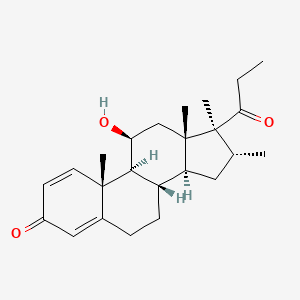



1. 11 Beta-hydroxy-16 Alpha,17 Alpha,21-trimethylpregna-1,4-diene-3,20-dione
2. Org 6216
3. Org-6216
4. Rimexel
5. Vexol
1. Vexol
2. 49697-38-3
3. Rimexolon
4. Org-6216
5. Org 6216
6. Mls002154105
7. Rimexel
8. O7m2e4264d
9. Trimexolone
10. Rimexolona
11. Rimexolonum
12. Rimexolonum [inn-latin]
13. Rimexolona [inn-spanish]
14. Unii-o7m2e4264d
15. Rimexolone [usan:usp:inn:ban]
16. Vexol (tn)
17. Al 02178
18. Rimexolone [mi]
19. Rimexolone (usp/inn)
20. Rimexolone [inn]
21. Prestwick0_001020
22. Prestwick1_001020
23. Prestwick2_001020
24. Prestwick3_001020
25. Rimexolone [usan]
26. Rimexolone [vandf]
27. Rimexolone [mart.]
28. Rimexolone [usp-rs]
29. Rimexolone [who-dd]
30. Bspbio_001179
31. Schembl445300
32. Spbio_003050
33. Bpbio1_001297
34. Gtpl7099
35. Chembl1200617
36. Rimexolone [orange Book]
37. Rimexolone [usp Impurity]
38. Chebi:135566
39. Hms1571k21
40. Hms2098k21
41. Hms2235b18
42. Hms3715k21
43. Rimexolone [usp Monograph]
44. Hy-b1754
45. Zinc3945984
46. 11beta-hydroxy-16alpha,17,21-trimethyl-1,4-pregnadien-3,20-dion
47. Bdbm50103606
48. 11beta-hydroxy-16alpha,17alpha-dimethyl-17-propionylandrosta-1,4-dien-3-one
49. Al-2178
50. Ccg-221020
51. Db00896
52. Ncgc00179273-01
53. (8s,9s,10r,11s,13s,14s,16r,17s)-11-hydroxy-10,13,16,17-tetramethyl-17-propanoyl-7,8,9,11,12,14,15,16-octahydro-6h-cyclopenta[a]phenanthren-3-one
54. Smr001233413
55. Ab00514006
56. Cs-0013781
57. D05729
58. 697r383
59. Sr-01000841221
60. Q7334443
61. Sr-01000841221-2
62. Brd-k31627533-001-03-8
63. 11.beta.-hydroxy-16.alpha.,17.alpha.-dimethyl-17-propionylandrosta-1,4-dien-3-one
64. (11beta, 16alpha, 17beta)-11-hydroxy-16,17-dimethyl-17-(1-oxopropyl)androstra-1,4-dien-3-one
65. (11beta,16alpha,17beta)-11-hydroxy-16,17-dimethyl-17-(1-oxopropyl)androsta-1,4-dien-3-one
66. Androsta-1,4-dien-3-one, 11-hydroxy-16,17-dimethyl-17-(1-oxopropyl)-, (11.beta.,16,alpha.,17.beta.)-
67. Androsta-1,4-dien-3-one, 11-hydroxy-16,17-dimethyl-17-(1-oxopropyl)-, (11beta,16alpha,17beta)-
| Molecular Weight | 370.5 g/mol |
|---|---|
| Molecular Formula | C24H34O3 |
| XLogP3 | 3.5 |
| Hydrogen Bond Donor Count | 1 |
| Hydrogen Bond Acceptor Count | 3 |
| Rotatable Bond Count | 2 |
| Exact Mass | 370.25079494 g/mol |
| Monoisotopic Mass | 370.25079494 g/mol |
| Topological Polar Surface Area | 54.4 Ų |
| Heavy Atom Count | 27 |
| Formal Charge | 0 |
| Complexity | 749 |
| Isotope Atom Count | 0 |
| Defined Atom Stereocenter Count | 8 |
| Undefined Atom Stereocenter Count | 0 |
| Defined Bond Stereocenter Count | 0 |
| Undefined Bond Stereocenter Count | 0 |
| Covalently Bonded Unit Count | 1 |
| 1 of 2 | |
|---|---|
| Drug Name | Vexol |
| PubMed Health | Rimexolone (Into the eye) |
| Drug Classes | Ophthalmologic Agent |
| Drug Label | VEXOL 1% Ophthalmic Suspension is a sterile, multi-dose topical ophthalmic suspension containing the corticosteroid, rimexolone. Rimexolone is a white, water-insoluble powder with an empirical formula of C24H34O3 and a molecular weight of 370.53. I... |
| Active Ingredient | Rimexolone |
| Dosage Form | Suspension/drops |
| Route | Ophthalmic |
| Strength | 1% |
| Market Status | Prescription |
| Company | Alcon |
| 2 of 2 | |
|---|---|
| Drug Name | Vexol |
| PubMed Health | Rimexolone (Into the eye) |
| Drug Classes | Ophthalmologic Agent |
| Drug Label | VEXOL 1% Ophthalmic Suspension is a sterile, multi-dose topical ophthalmic suspension containing the corticosteroid, rimexolone. Rimexolone is a white, water-insoluble powder with an empirical formula of C24H34O3 and a molecular weight of 370.53. I... |
| Active Ingredient | Rimexolone |
| Dosage Form | Suspension/drops |
| Route | Ophthalmic |
| Strength | 1% |
| Market Status | Prescription |
| Company | Alcon |
For the treatment of postoperative inflammation following ocular surgery and in the treatment of anterior uveitis.
FDA Label
Rimexolone is a glucocorticoid corticosteroid for systemic use. Corticosteroids suppress the inflammatory response to a variety of inciting agents of a mechanical, chemical, or immunological nature. They inhibit edema, cellular infiltration, capillary dilatation, fibroblastic proliferation, deposition of collagen and scar formation associated with inflammation.
Glucocorticoids
A group of CORTICOSTEROIDS that affect carbohydrate metabolism (GLUCONEOGENESIS, liver glycogen deposition, elevation of BLOOD SUGAR), inhibit ADRENOCORTICOTROPIC HORMONE secretion, and possess pronounced anti-inflammatory activity. They also play a role in fat and protein metabolism, maintenance of arterial blood pressure, alteration of the connective tissue response to injury, reduction in the number of circulating lymphocytes, and functioning of the central nervous system. (See all compounds classified as Glucocorticoids.)
H - Systemic hormonal preparations, excl. sex hormones and insulins
H02 - Corticosteroids for systemic use
H02A - Corticosteroids for systemic use, plain
H02AB - Glucocorticoids
H02AB12 - Rimexolone
S - Sensory organs
S01 - Ophthalmologicals
S01B - Antiinflammatory agents
S01BA - Corticosteroids, plain
S01BA13 - Rimexolone
Absorption
Systemically absorbed.
Route of Elimination
Following IV administration of radio-labelled rimexolone to rats, greater than 80% of the dose is excreted via the feces as rimexolone and metabolites.
Undergoes extensive metabolism. Following intravenous administration of radiolabeled rimexolone in rats, more than 80% of the dose was excreted in the feces as rimexolone and metabolites. Metabolites have been shown to be either less active than rimexolone or inactive in human glucocorticoid receptor binding assays.
The serum half-life of rimexolone could not be reliably estimated due to the large number of samples below the quantitation limit of the assay (80 pg/mL). However, based on the time required to reach steady-state, the half-life appears to be short (1-2 hours).
Rimexolone is a glucocorticoid receptor agonist. The antiinflammatory actions of corticosteroids are thought to involve lipocortins, phospholipase A2 inhibitory proteins which, through inhibition of arachidonic acid, control the biosynthesis of prostaglandins and leukotrienes. By binding to the glucocorticoid receptor, this drug ultimately leads to changes in genetic transcription involving the lipocortins and prostaglandins.